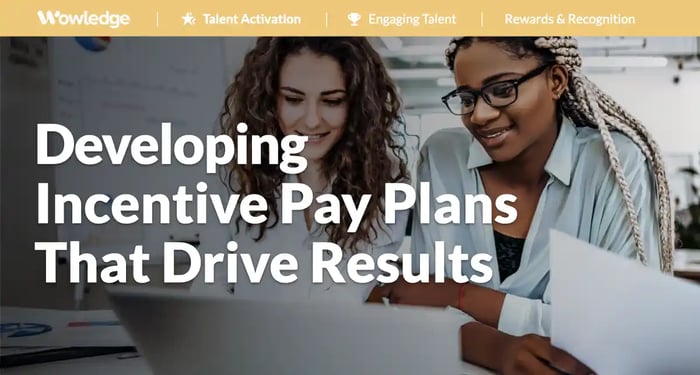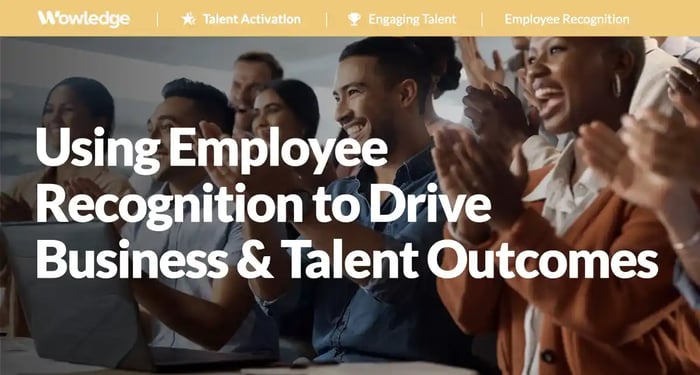Table of Contents
One of the key roles of a CHRO/CPO or HR business partner (HRBP) is to understand and address the business and talent challenges that their organization faces. This includes developing timely, responsive, effective solutions, particularly in compensation design and plan development. The ability to apply and guide the development of incentive pay plans is a critical value-add, underscoring the importance of your role in the organization's success.
The effectiveness of incentive pay plans is evident in the 84% of companies that use targeted strategies to further incentivize their top-performing workers. Adding incentive pay to employees’ base wages addresses the gap in standard performance management and merit pay processes. This motivates employees to exceed performance expectations and provides the recognition they deserve for their hard work, contributing to a positive work environment.
For example, Gallup has shown that pay and benefit levels are the most common reasons for turnover in the prior year. This relates to employee dissatisfaction with the lack of recognition at work, with 10% of workers reporting that they do not feel valued. Worse yet, that group includes 49% of females and 49% of people of color.
The opportunity for HR teams lies in deploying incentive pay plans. This is a crucial role, as 85% of workers believe that managers should provide praise whenever they observe or hear about quality work. Furthermore, 52% of employees state that an annual bonus helps them feel more appreciated, and 88% express a “strong preference” for cash bonuses. The role of the HR leader in deploying these plans is integral to the organization's success and the satisfaction of its employees.
Defining “incentive pay”
Incentive pay is a form of variable employee compensation, meaning that the payment and amount are not guaranteed, are performance-based, and are made available in addition to the eligible employee’s hourly or salary wages. Eligibility is directly tied to achieving defined performance goals, objectives, or milestones. They are typically designed as supplements to the organization’s job architecture and pay structures, often to address short-term issues or opportunities related to the need to drive enhanced employee performance, productivity, focus, and attention
They are related to rewards and recognition programs in that the awarding of a cash incentive is simultaneously a recognition event, which amplifies its power to affect and drive employee performance and behavior. Their value lies in their ability to communicate what is most important (at that moment) to an organization, as employees perceive that the company is “putting its money where its mouth is” or taking action that supports its stated priorities and position relative to what is most valued.

The value of deploying incentive pay plans
Developing and offering incentive pay plans or programs creates a tangible reason for employees to expend extra effort and change their everyday priorities toward what the organization has determined to be an immediate concern. It grabs employees’ attention in ways that can drive substantial advantages, including:
- Separate the company from its competitors with the same jobs. Using creative opportunities for workers to earn extra cash can help attract and retain high performers who might be swayed by small increases available elsewhere or need a second job given existing market-based pay levels.
- Incentivize employee production above expected levels. These can drive employees to put forth more effort, work more efficiently, and work longer hours to achieve the elevated goals.
- Drive performance in otherwise challenging circumstances. Incentive pay can be used to maintain employee performance and productivity levels during business slowdowns, rumored closings or acquisitions, or market downturns.
- Fund higher levels of compensation than might otherwise be affordable. As incentive pay is not guaranteed, higher revenue or profitability can offset its use. Given the lower rates of pay offered to low- or unskilled labor, increased productivity can be used as a basis for paying the best performers higher effective rates of pay.
- Prioritize employee targets for focus. These pay schemes provide the company with a clear and well-defined direction for focusing employee work behaviors. They communicate what is most important for employees and can help guide their use of discretionary work time and effort towards specific organizational goals.
- Communicate the value of high performance. Using these supplemental pay plans reinforces how much the company appreciates the over-achievement of individual (or team) work objectives. They send the message that working diligently to exceed job requirements is so crucial to organizational success that it will share the proceeds of those efforts and results.
Of equal importance, incentive pay plans can reinforce the company’s culture and corporate values. For example, organizations can develop plans aligned with and promote objectives such as a culture of performance, customer success, teamwork, etc.
Incentive pay is linked to higher talent and business outcomes
Data supporting the positive outcomes of incentive pay is abundant. Considering that it represents an essential form of recognition, research has found that 65% of employees reported a willingness to work harder if they felt that their managers noticed their contributions. Another study found that 37% of surveyed employees reported that more appreciation from their managers would motivate them to produce better quality work more frequently.
Recognition is also highly correlated with improved employee outcomes, with 14% higher employee engagement, productivity, and performance in organizations with recognition programs than in companies lacking them. Interestingly, those organizations also generated a 12% higher customer satisfaction rate. Turnover rates are unsurprisingly lower in organizations that prioritize employee recognition and rewards, with their workers being 56% less likely to be looking elsewhere for a new role. Another study found that incentive pay is significantly and positively related to enhanced employee satisfaction, organizational commitment, and trust in their management.
Types of incentive pay plans
It is essential to understand that incentive pay plans are supplemental pay-for-performance programs. They differ from other programs labeled “alternative rewards,” which generally refer to non-monetary plans that provide cash-value awards such as “reward marketplaces” that grant points to purchase travel, gifts, etc. They are also separate and distinct from pure recognition programs or processes, stock, or other equity-related programs. Common examples of incentive pay plans include:
| Type | Purpose/Use | Details |
| Profit-sharing plans | To incentivize employees to focus on organizational goals and priorities. | Pre-determined opportunity based upon a defined percentage of profits achieved. |
| Sales or service SPIFs (sales performance incentive fund) | Increase short-term sales volume with a targeted focus on a product or service sales goal. It is also helpful in handling market or public relations issues by focusing employees on customer engagement. | Funding is determined by the financial value of customer acquisition or retention during slow or difficult market conditions. |
| Signing or stay bonuses | Incentives job offer acceptance, employee retention, and a focus on mission and goals. | Targeted to critical role new hires, those who will lose bonus or commission opportunities Typical for retaining critical employees with upcoming mergers, acquisitions, and divestitures. |
| Targeted bonus opportunities | To enhance the financial position of lower- or mid-level roles and motivate targeted contributions. | Line workers and support staff or for employee referrals, projects needing to meet tight deadlines, etc. |
| Spot bonuses | For unique, unplanned, but significant contributions or achievements. | Most often awarded at managers’ discretion. It may include gift cards. |
| Gainsharing | Rewards financial improvements by teams to boost efforts and rally the troops around a shared objective. | Incentives for team efforts to drive revenue growth, cost reduction, process or product/service improvements, etc. |
| Profit-sharing bonus | Awarded for exceptionally high-profit performance vs. plan or expectations. | Individual, group, or all-employee based on the discretion of top leadership/BOD. Awards tied to employee salary/wage levels. |
| Health and Wellness Incentives | For employees who improve key health metrics (BP, cholesterol, BMI). It helps drive lower health care costs, illness or injuries, etc. | Awards can be cash or payouts for free or discounted spa days, gym memberships, etc. |
Designing and developing incentive pay plans
As previously noted, many non-compensation professionals may lack the skill to identify opportunities and create a specialized incentive plan. Yet, it often represents a potent response to specified talent and business challenges that add significant heft to the CHRO/CPO or HRBP tool chest. The following process can be used to define and develop a plan, most commonly in conjunction with the compensation and Finance teams, who bring crucial modeling and affordability analysis skillsets.
1. Recognizing a targeted need and opportunity
The first step is recognizing the opportunity to respond to a business challenge using an incentive pay plan. This comes from participating in leadership discussions around specific challenges or goals needing special attention. Frequently, such opportunities arise from leadership staff meetings, strategic plan review sessions, or sales, service, production, or project performance status reviews. They are often short-term needs requiring a boost to get the planned performance back on track or longer-term needs to improve talent or business outcomes.
2. Identify the objective of the incentive
Articulate the desired employee behaviors or performance to be targeted in clear and straightforward language, with metrics and objectives that are easy to understand and act upon. Consider the extent to which those behaviors are a) possible - within targeted employees’ skills and capabilities to change and improve, and b) within their discretion - not requiring managerial approvals or blessings. The behaviors and performance targeted for increases must be considered achievable by the employees to avoid the backlash that the company is asking too much. In that spirit, it is critical to validate the assumptions of achievability with line managers and leaders and refine the concept per their feedback.
3. Assess the compensation opportunity
Next, consider how much additional pay should be offered to employees. Start by projecting/modeling (with Finance and Sales) the revenue or profit opportunity level that a particular percentage improvement in employee effort, productivity, or production could achieve. For example, if employees were 5-10% more productive in their sales, service, or production output, how much revenue or profit would that generate? Knowing that such an increase might not be sustainable for more than 30, 60, or 90 days with the existing staff, what would the financial boost look like?
Next, the market pay data for each job family, level, and role proposed for eligibility is reviewed. How much compensation would it take to move the average worker to 102-105% of the market rate for each job? 105-110%? What would the total bill be for that additional pay cost (daily, weekly, or monthly)? How does that compare to the projected revenue or profit gains? That comparison should drive a calculation of how much to share with employees. A model of those costs/payouts then helps generate a budget per head, balanced with the impact of potential wage increases on their market rates.
4. Develop performance criteria and rules
Clarifying the rules for participation is essential at this point. Determine and document eligibility (who is covered), a timeframe for the program, payout frequency (accumulation vs. pay as earned), any performance or participation minimums that must be met, and whether the payouts will be based on team vs individual performance.
Additional considerations to be documented include guidelines for individuals, such as:
Criteria for participation
- Attendance, days worked, individual minimums
- Minimum tenure addressing new hires
- Payout eligibility in cases of transfer, merit increase, promotion, resignation, termination for cause, etc.
Performance standards that must be met, maintained
- Clarifying what is being incented – teamwork and team performance vs. individual contributions to team goals, etc.
- Minimum production and contribution goals by the team and individual
- Payout levels/targets for different roles and pay grades/levels
Governance/oversight structure
- Program sponsors, owners, and administrators
- Key measures/KPIs and reporting requirements
- Monitoring plans with schedules for meetings, attendees, report distribution, and decision-makers
5. Present the concept or model
Once designed, the entire plan should be presented to leadership for review, discussion, and approval. The presentation should communicate the plan’s purpose and rationale, timeframe, financial impact analyses, criteria, administrative guardrails, measurement and reporting, and governance structure. The goal is to provide clarity and a business case for leadership for awareness, understanding, and buy-in. After approval has been achieved, communications with the impacted employees can proceed, where the plan’s purpose and rationale are presented, with transparency around their role, program criteria, requirements, performance standards and expectations, and payout schedules are reviewed.
6. Tracking and reporting
For incentives that affect more extensive groups of employees, such as profit- or gainsharing programs, SPIFFs, etc., public sharing of progress and results with all stakeholders is essential to successful implementation. Others that involve individuals (spot, health and wellness, sign-on, retention bonuses) should be communicated by their manager with congratulations or thank-you.
For all of these, however, creating online dashboards and communicating with key stakeholders should be done formally and regularly. Keeping them engaged and aware of progress (and utilization rates) is critical to sustainability. Of particular importance is tracking and reporting desired/planned outcomes to demonstrate the extent to which the incentive pay plan is achieving its purpose and goals.
Issues and considerations with incentive pay
While incentive pay plans are popular, they should be chosen, designed, and implemented with an awareness of several downsides that can drain some of their advantages and perceived value. Care should be taken to prepare leaders and sponsors for these so they are seen as flawless panaceas for the issues they are designed to address.
They can lose their luster and opportunity to excite
Some types of cash incentives, such as annual performance bonuses, are often viewed as guaranteed to the average-to-high performers who earn them every year. While the amount earned might vary, when payouts are consistent, they can quickly become viewed as a part of the guaranteed salary. For example, when payouts have been high due to an exceptional stretch of years with above-target payouts, a return to the norm can dissatisfy many. One expert pointed out that “a reward can lose its motivational power when considered a sure thing.” As a result, focusing on the short-term and targeted nature of an incentive pay plan can help avoid these issues.
They are taxable and more costly than the award amount
Cash incentives are subject to taxation by the IRS and need to be reported as added income as payouts are made. Between federal, state, and local taxes, actual employee payouts can be 20-30% lower than communicated, and the company has to contribute another 10-12% in its share of the taxes. Consideration of the post-tax employee payout amounts is required to ensure that the amount paid is meaningful to individuals at different compensation levels.
They can inadvertently create competition for the awards
When individual incentive pay plans are created, they can harm collaborative behaviors if employees perceive their best avenue towards earning them as a “win-lose” proposition. It is essential to carefully consider and craft the participation and earning criteria to entice people to work together for the common good and towards a shared set of goals and objectives. Having robust reporting and controls in place to avoid unethical, fraudulent, or otherwise harmful behaviors is critical. Payout monitoring should look out for overachievers and review results to ensure plan and company standards adherence. Similarly, managers should watch for over- (or anti-) competitive behaviors that might reduce the intended motivational effect on all eligible employees.
They can limit the motivation of top performers
Classic research in behavioral psychology informs us that incentivizing what is otherwise a self-rewarding behavior limits the impact of the extrinsic (cash) required. When designing the incentive pay plan, avoid any design intended to get the bottom 80% of performers to do what the top 20% already do on the job. An example is the heightened focus on customer satisfaction, which may be a top priority, and the self-rewarding behavior of top performers who deliver excellent customer service because it brings them pride and satisfaction. The key is to create incentives that will appeal to most employees performing the work or output that needs to be boosted.
Relevant Practices & Tools
Core Performance Management Practices to Set Expectations and Provide Effective Feedback. >
Performance management engages employees and their managers in the annual process of planning critical work efforts and developmental activities, evaluating the extent... more »
Leveraging Multiple HR Systems and Sources When Producing Integrated Metrics. >
As manager requests grow in sophistication, an appetite for more complex data will rise. This will most typically include data from numerous HR processes and systems... more »
Matching Clear Criteria to Modern Rewards and Recognition to Drive Targeted Behaviors. >
While the processes remain separate in emerging Performance Management, compensation and career development remain integrated with and enabled by it... more »
Making Compensation Decisions that Align with Observed Performance. >
Compensation or pay issues generally flow from the performance evaluation – the better the evaluation, the higher the potential rewards... more »
The Change Impact Analysis Template: Identify and Assess how Initiatives Impact the Company. >
This template provides a structure to document how specific stakeholder groups will be impacted by an initiative and measure the degree of change... more »
About Wowledge
Wowledge is the expert-driven platform for lean teams building strategic HR programs. Members enjoy access to up-to-date best practices, step-by-step guides, tools, templates, and insights to accelerate the design and implementation of all key HR programs and processes.
Since each organization has unique characteristics, needs, and aspirations, Wowledge's practices are developed utilizing an exclusive stage-based approach – from Core to Advanced to Emerging – that reflects distinct levels of sophistication to meet our members where they are.
Build strategic HR programs with refreshingly easy-to-follow best practices.
Get started for FREE! Learn more.










